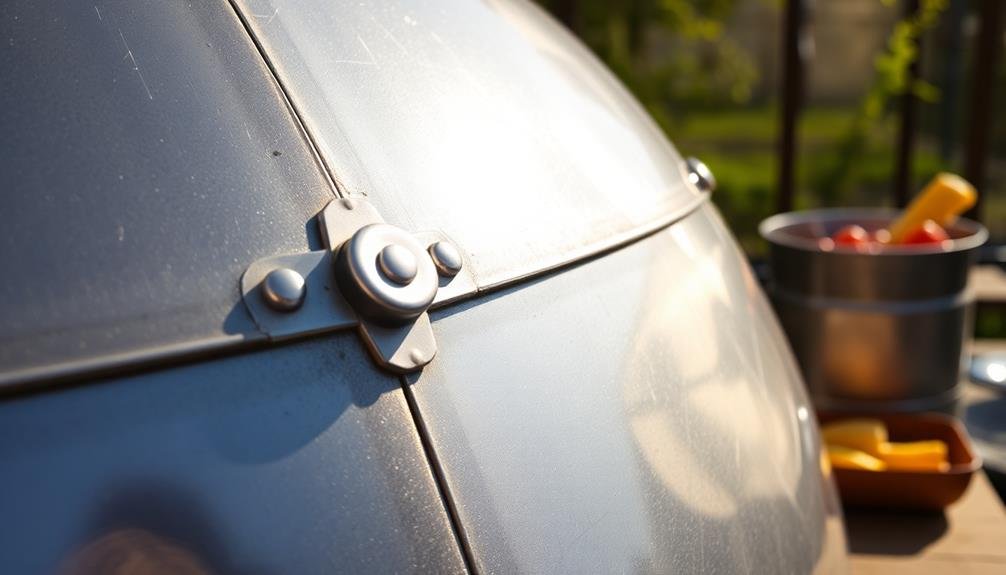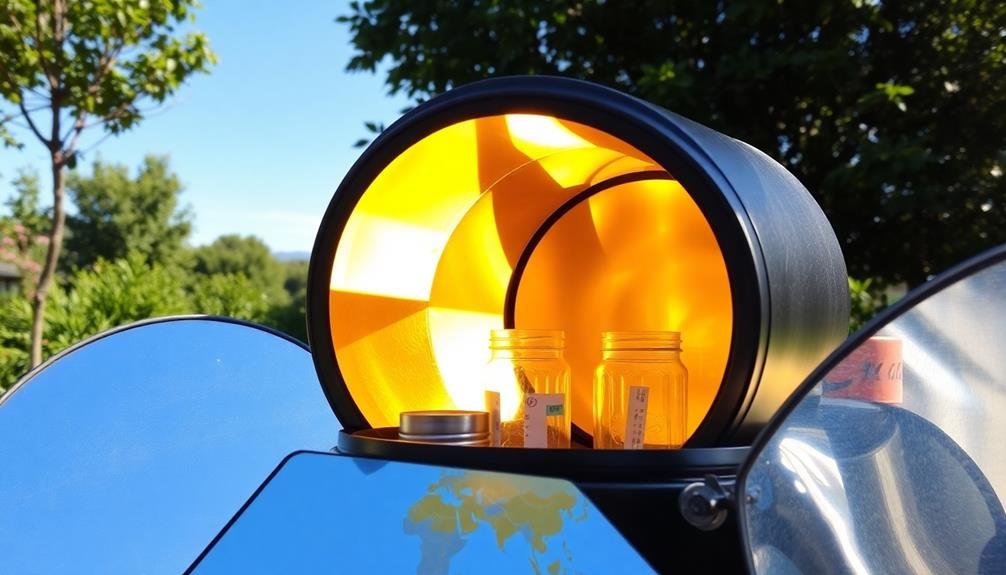To weatherproof your solar oven for outdoor cooking, start with waterproof coatings and sealants on vulnerable areas. Use protective covers or tarps when not in use, and select durable, UV-resistant materials for construction. Implement proper drainage design to prevent water accumulation, and reinforce joints and seams for structural integrity. Apply UV-resistant treatments to all exposed surfaces, and employ rust prevention techniques on metal components. Regular maintenance, including cleaning and reapplication of protective coatings, is essential. Consider environmental factors like humidity and seasonal changes when storing your oven. By implementing these strategies, you'll guarantee your solar oven stands up to the elements and serves you well for years to come.
Waterproof Coatings and Sealants

Waterproof coatings and sealants are vital components in weatherproofing your solar oven. They create a protective barrier against moisture, preventing water damage to the oven's materials and internal components. You'll want to choose high-quality, UV-resistant products designed for outdoor use to guarantee long-lasting protection.
When applying coatings, focus on vulnerable areas like seams, joints, and edges. Use a marine-grade sealant for maximum water resistance. Silicone-based sealants work well for high-temperature applications.
For the oven's exterior, consider a waterproof paint or spray-on coating that's specifically formulated for outdoor equipment.
Don't forget to treat wooden parts with a water-repellent wood preservative. This will prevent warping and rot. For metal components, apply a rust-inhibiting primer before the final coating.
If your oven has a glass or plastic window, use a hydrophobic coating to maintain clarity and repel water.
Regular maintenance is essential. Inspect your solar oven periodically for signs of wear or damage to the waterproof layers.
Reapply coatings and sealants as needed, typically every 1-2 years, depending on your climate and usage frequency. This proactive approach will greatly extend your solar oven's lifespan and efficiency.
Protective Covers and Tarps
Beyond waterproof coatings, protective covers and tarps offer an additional layer of defense for your solar oven against the elements. These accessories shield your oven from rain, snow, dust, and debris when it's not in use. You'll find various options available, from custom-fitted covers to multipurpose tarps.
When selecting a protective cover, consider factors like material durability, UV resistance, and breathability. Opt for covers made from water-resistant fabrics such as polyester or nylon with a weather-resistant coating. Make certain the cover fits snugly around your solar oven to prevent wind from lifting it.
Here's a comparison of different protective cover options:
| Cover Type | Pros | Cons | Durability | Cost |
|---|---|---|---|---|
| Custom-fitted | Perfect fit, tailored protection | Limited versatility | High | High |
| Universal | Fits multiple oven sizes | May not provide ideal coverage | Medium | Medium |
| Tarp | Versatile, multi-use | Requires securing, less aesthetically pleasing | High | Low |
| DIY cover | Cost-effective, customizable | Time-consuming, varying quality | Varies | Low |
| Insulated cover | Added thermal protection | Bulky, expensive | High | High |
Remember to remove the cover before use and allow your solar oven to dry completely before storing it to prevent mold growth.
Durable Material Selection

Selecting durable materials for your solar oven is essential for long-term weatherproofing success. When choosing materials, prioritize those that can withstand prolonged exposure to sunlight, heat, and moisture.
Opt for UV-resistant plastics or tempered glass for the oven's transparent cover, as they'll maintain clarity and structural integrity over time. For the oven's body, consider using aluminum or stainless steel, which offer excellent durability and heat conductivity.
Don't overlook the importance of high-quality insulation materials. Rock wool or fiberglass insulation can effectively retain heat while resisting moisture.
For the reflective surfaces, choose materials like polished aluminum or mylar, which are resistant to tarnishing and maintain their reflective properties.
When selecting fasteners and hardware, opt for corrosion-resistant options like stainless steel or brass. These will prevent rust and guarantee your oven's components stay securely in place, even in harsh weather conditions.
Key considerations for durable material selection:
- UV resistance for exposed components
- Moisture resistance for insulation and seals
- Corrosion resistance for metal parts and fasteners
Proper Drainage Design
To guarantee your solar oven's longevity, proper drainage design is essential. When designing your solar oven, focus on creating sloped surfaces and strategically placed drainage holes to prevent water accumulation. Ascertain the top of the oven has a slight angle to allow rainwater to run off easily. Incorporate small gutters or channels along the edges to direct water away from vulnerable areas.
Install drainage holes at the lowest points of your solar oven, particularly in corners and recessed areas where water might collect. These holes should be large enough to allow water to escape quickly but small enough to maintain the oven's insulation properties. Consider using mesh screens over the holes to prevent debris and insects from entering.
Don't forget about condensation inside the oven. Design internal drainage pathways that guide moisture towards the exit points. Use hydrophobic materials or coatings on interior surfaces to reduce water adhesion.
Regularly inspect and clean drainage systems to prevent clogs and ascertain ideal performance. By implementing these drainage design techniques, you'll greatly enhance your solar oven's resistance to water damage and extend its lifespan in outdoor conditions.
Reinforced Joints and Seams

While proper drainage protects your solar oven from water damage, reinforced joints and seams guarantee its structural integrity in harsh weather conditions.
When building or upgrading your solar oven, focus on strengthening these critical points to withstand wind, rain, and temperature fluctuations.
Use high-quality, weather-resistant adhesives specifically designed for outdoor use. Apply them generously along all seams and joints, guaranteeing a tight seal.
Consider adding silicone caulk for extra protection against moisture infiltration. Reinforce corners and edges with metal brackets or corner protectors, which will prevent warping and separation over time.
For fabric-based solar ovens, double-stitch all seams and use heavy-duty, UV-resistant thread. Apply waterproof seam sealant to prevent fraying and water penetration.
If your oven has a glass or plastic window, guarantee it's securely fastened with weather-stripping and sturdy framing.
- Choose materials that can withstand thermal expansion and contraction
- Regularly inspect and maintain joints and seams to prevent degradation
- Consider modular designs for easier repairs and replacements
UV-Resistant Treatments
UV-resistant treatments are essential for extending the lifespan of your solar oven. These protective measures shield your oven's materials from the sun's harmful ultraviolet rays, which can cause degradation, discoloration, and brittleness over time.
To weatherproof your solar oven effectively, you'll want to apply UV-resistant coatings or treatments to all exposed surfaces.
For wooden components, use a UV-resistant sealant or varnish. These products contain special additives that absorb or reflect UV rays, preventing them from damaging the wood's cellular structure. Apply multiple thin coats for peak protection.
If your solar oven has metal parts, consider using a UV-resistant paint or powder coating. These finishes not only protect against UV radiation but also prevent rust and corrosion.
For plastic components, look for UV-stabilized materials or apply a UV-resistant clear coat.
Don't forget about your oven's reflective surfaces. Use UV-resistant reflective films or coatings to maintain their efficiency and prevent degradation.
Regularly clean and reapply these treatments as needed to guarantee long-lasting protection.
Rust Prevention Techniques

In light of the harsh outdoor conditions solar ovens face, rust prevention is essential for maintaining their longevity and efficiency. To protect your solar oven from rust, you'll need to focus on the metal components, particularly those made of iron or steel.
Start by applying a rust-resistant primer to all exposed metal surfaces before painting them with a high-quality, weather-resistant enamel paint. For added protection, consider using a clear coat sealant over the painted surfaces. This will create an extra barrier against moisture and oxidation.
Don't forget to regularly inspect your solar oven for any signs of rust or paint damage, and touch up these areas promptly to prevent further corrosion.
To enhance your rust prevention efforts:
- Use stainless steel fasteners and hardware whenever possible
- Apply a thin layer of food-grade mineral oil to metal surfaces after each use
- Store your solar oven in a dry place when not in use
If you live in a particularly humid or coastal area, you may want to invest in a dehumidifier for your storage space. This will help reduce the moisture in the air, further minimizing the risk of rust formation on your solar oven's metal components.
Frequently Asked Questions
How Long Does a Typical Solar Oven Last With Proper Weatherproofing?
You'll find that a well-maintained solar oven can last 10-15 years or more. With proper weatherproofing and regular care, you're looking at a decade-plus of outdoor cooking. Don't forget to clean and inspect it regularly for best results.
Can Solar Ovens Be Used Effectively in Extreme Cold Temperatures?
You can use solar ovens in extreme cold, but they're less effective. You'll need direct sunlight and longer cooking times. Insulation is essential. Consider pre-heating ingredients and using reflectors to maximize sunlight capture in frigid conditions.
What's the Maximum Wind Speed a Weatherproofed Solar Oven Can Withstand?
You'll find most weatherproofed solar ovens can handle winds up to 15-20 mph. However, some high-end models claim to withstand gusts up to 30-35 mph. It's best to secure your oven and monitor conditions closely.
Are There Specific Maintenance Routines for Weatherproofed Solar Ovens?
You'll need to regularly clean your weatherproofed solar oven's reflectors and cooking chamber. Check seals and hinges for wear, and reapply weatherproofing coatings as needed. Don't forget to inspect for any cracks or damage after storms.
How Does Altitude Affect the Performance of Weatherproofed Solar Ovens?
You'll find that higher altitudes generally improve your solar oven's performance. There's less atmosphere to filter sunlight, so you'll get more intense solar radiation. However, you'll also face cooler temperatures, which may offset some gains.
In Summary
You've got several options to weatherproof your solar oven for outdoor cooking. Apply waterproof coatings, use protective covers, and choose durable materials. Don't forget proper drainage design and reinforced joints. UV-resistant treatments will protect against sun damage, while rust prevention techniques keep metal parts in good shape. By combining these methods, you'll create a resilient solar oven that can withstand various weather conditions. Enjoy your outdoor cooking adventures with confidence!





Leave a Reply